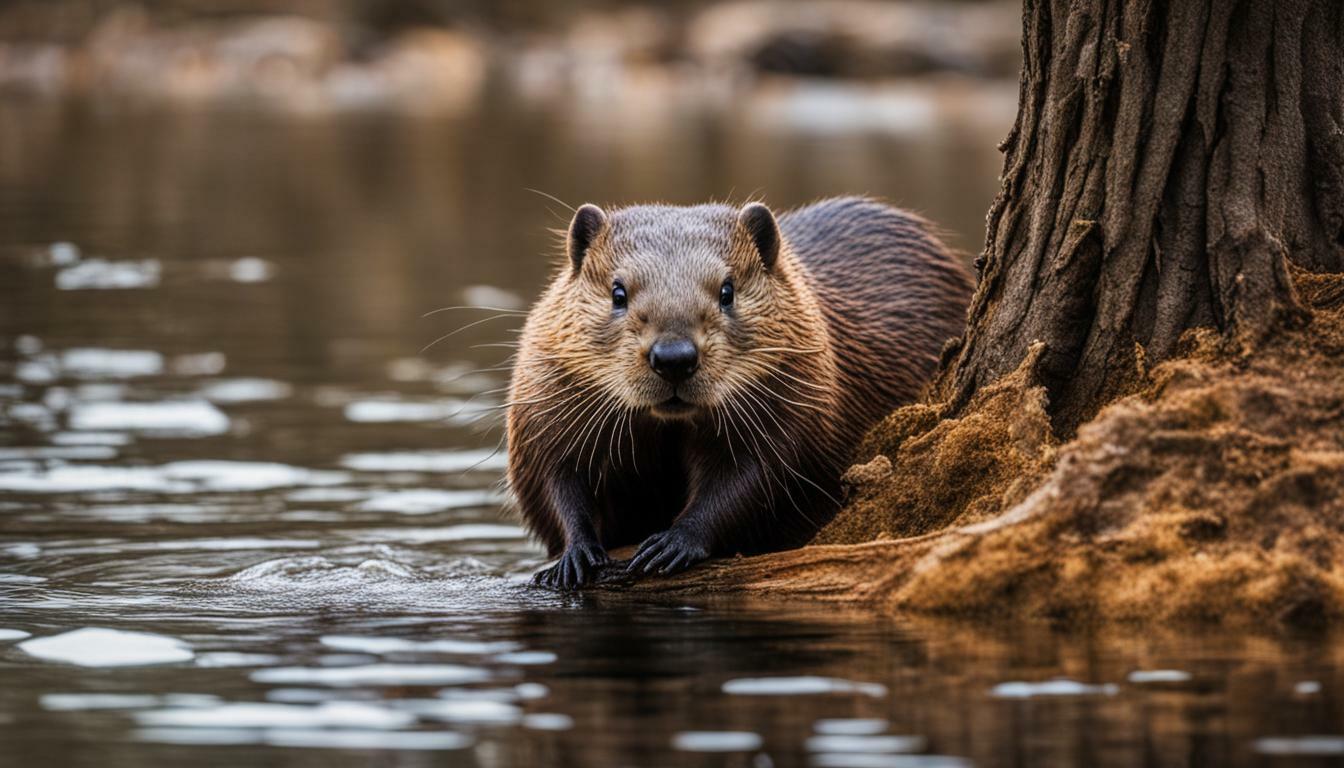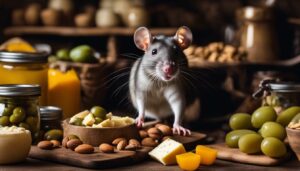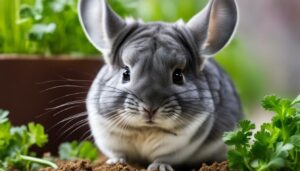Have you ever wondered if beavers are marsupials? In this comprehensive guide, we’ll explore the fascinating world of these animals and uncover surprising facts to answer this question.
Key Takeaways:
- Beavers are not marsupials but are castorimorph rodents.
- They are known for their elaborate social behaviors and construction capabilities.
- Beavers have webbed hind feet and broad, scaly tails.
- They are herbivores and prefer the wood of certain tree species.
- Beavers build dams on rivers and create lodges in the ponds formed by their dams.
Beaver Characteristics
Beavers are not your typical furry creatures – they possess a range of interesting characteristics and adaptations that set them apart. As castorimorph rodents, beavers are the second largest rodents in the world, surpassed only by the capybara. Their unique physical features include webbed hind feet and broad, scaly tails. These adaptations make them excellent swimmers, allowing them to navigate through water with ease.
One of the most remarkable aspects of beavers is their construction capabilities. They are natural builders, constructing intricate dams on rivers and creating lodges in the ponds formed by their dams. These structures serve as their homes and provide protection from predators. The dams also have a significant impact on the environment, creating wetlands that support a wide variety of plant and animal species.
Beavers are herbivores, primarily feeding on the wood of certain tree species. They have strong, chisel-like front teeth that enable them to gnaw through tree trunks and branches. Their diet consists mainly of bark and twigs, although they also consume leaves, aquatic plants, and roots. As they feed, they contribute to the natural process of tree regeneration, as well as shaping the landscape through their selective cutting.
| Beaver Characteristics: |
|---|
| Webbed hind feet |
| Broad, scaly tail |
| Strong, chisel-like front teeth |
| Herbivorous diet |
| Excellent swimming abilities |
Beaver Habitat
Find out where beavers make their homes and how their behavior contributes to shaping their habitat.
Beavers are known for their remarkable ability to transform their environment to suit their needs. They typically make their homes in and around bodies of water, such as streams, rivers, and lakes. These aquatic habitats provide beavers with the necessary resources for their survival and enable them to thrive.
One of the most distinctive features of a beaver habitat is the presence of dams. Beavers are skilled builders and create dams by felling trees and using them to block the flow of water. These dams serve multiple purposes. They create deep ponds that provide protection from predators and allow beavers to store food for the winter. Additionally, these ponds contribute to the overall health of the ecosystem by creating wetland habitats that support a diverse range of plant and animal species.
Beavers’ behavior also plays a crucial role in shaping their habitat. They are herbivores and have a particular preference for the wood of certain tree species, such as aspen, willow, and birch. By selectively harvesting these trees for food and building materials, beavers can influence the composition and structure of the surrounding vegetation. This, in turn, affects the availability of food and shelter for other organisms within the ecosystem.
In summary, beavers make their homes in and around bodies of water, where they construct dams to create ponds. These habitats support a diverse range of plant and animal species, making beavers a keystone species. By selectively harvesting trees, beavers shape the surrounding vegetation and contribute to the overall health and balance of their habitat.
| Beaver Habitat | Beaver Behavior |
|---|---|
| – Bodies of water: streams, rivers, lakes | – Herbivores: preference for certain tree species |
| – Construction of dams | – Selective tree harvesting |
| – Creation of ponds and wetland habitats | – Influence on vegetation composition and structure |
Beaver Construction Capabilities
Discover the astonishing construction capabilities of beavers, including their impressive dam-building skills and lodge construction techniques. Beavers are renowned for their ability to modify their environment, creating complex structures that serve a variety of purposes.
When building dams, beavers strategically select the ideal location in a river or stream, typically where the water is deep enough to provide protection from predators. They use their strong, chisel-like teeth to fell trees, cutting them into manageable lengths. With precise precision, they then maneuver these logs into position, creating a barrier that slows down the water flow and creates a pond. This not only provides them with easier access to food but also creates an ideal habitat for various aquatic plants and animals.
In addition to dam-building, beavers construct lodges that serve as their homes. These lodges are typically located within the ponds formed by their dams. Beavers use a combination of mud, sticks, and rocks to build their lodges, which have multiple chambers for different purposes. The entrance to the lodge is strategically positioned underwater, serving as an additional layer of protection against predators.
Beaver Construction Capabilities at a Glance:
| Dam Building | Lodge Construction |
|---|---|
| Strategic selection of ideal dam location | Use of mud, sticks, and rocks |
| Felling trees and cutting them into logs | Multiple chambers for different purposes |
| Precise positioning of logs to create a barrier | Entrance strategically placed underwater |
| Creation of ponds for easier access to food | Protection against predators |
These construction capabilities of beavers not only demonstrate their adaptability and intelligence but also highlight their role as ecosystem engineers. By shaping their environment through dam-building and lodge construction, beavers create valuable habitats for a wide range of plant and animal species, making them a crucial keystone species in many ecosystems.
While beavers continue to showcase their remarkable construction skills, it is important to acknowledge the threats they face. Habitat destruction and degradation, primarily due to human activities, pose significant challenges to beaver populations. By raising awareness and implementing conservation efforts, we can ensure the survival of these exceptional creatures and the habitats they create.
Beaver as Castorimorph Rodents
Learn about the scientific classification of beavers as castorimorph rodents, placing them among the fascinating diversity of rodents in the animal kingdom.
Beavers, scientifically known as Castor canadensis, are part of the Castorimorpha suborder, which also includes their close relatives, the gophers and pocket mice. This classification groups beavers with other rodents that are characterized by their unique dental features and adaptations to aquatic environments.
Belonging to the order Rodentia, beavers are the second-largest rodents in the world, after the capybaras. They are known for their large, flattened tails, webbed hind feet, and sharp, chisel-like incisors that never stop growing, allowing them to gnaw through wood with ease.
Table: Comparison of Beavers and Other Rodents
| Characteristics | Beavers | Gophers | Pocket Mice |
|---|---|---|---|
| Dental Features | Large, chisel-like incisors for wood-cutting | Smaller incisors adapted for burrowing | Sharp incisors for seed-cracking |
| Body Adaptations | Webbed hind feet, flattened tail | Strong forelimbs for digging | Long, narrow tails for balance |
| Habitat Preference | Aquatic environments, lakes, and rivers | Underground burrows in prairies | Sandy or desert-like regions |
As castorimorph rodents, beavers play a vital role in shaping their environment. Their exceptional construction capabilities include building dams on rivers, using mud, sticks, and stones, to form ponds that provide habitat for a variety of aquatic species. The lodges they create within these ponds serve as shelter and protection for their families against predators.
By altering their surroundings, beavers create wetlands that benefit not only themselves but also countless other organisms. These wetlands act as water filters, improving water quality, and maintaining healthy ecosystems. Beaver dams also help to control flooding and erosion, making them essential for maintaining the ecological balance of their habitats.
Despite their ecological importance, beaver populations face threats due to habitat destruction and degradation. The loss of suitable habitats and the removal of trees for human development pose significant risks to their survival. Conservation efforts are essential to ensure the continued presence of these remarkable castorimorph rodents in our ecosystems.
Beavers and Keystone Species
Discover how beavers play a vital role as keystone species, influencing their ecosystem and providing habitat for many other species. Beavers are not marsupials, but rather castorimorph rodents, the second largest rodents in the world. They are known for their elaborate social behaviors and remarkable construction capabilities. With their webbed hind feet and broad, scaly tails, beavers are well-adapted for life in the water.
As herbivores, beavers primarily feed on the wood of certain tree species. However, their impact goes far beyond their diet. Beavers are famous for their ability to build dams on rivers, creating ponds that serve as their lodges. These dams have a significant impact on the surrounding environment, transforming it into a wetland ecosystem. The ponds created by beavers provide habitat for a wide range of plants and animals, making them crucial for biodiversity.
Beaver Dams and Wetland Ecosystems
The creation of beaver dams helps to regulate water flow, prevent erosion, and improve water quality. By slowing down the flow of water, the dams allow sediment to settle, resulting in clearer water. This creates ideal conditions for aquatic plants to thrive, which in turn provide food and shelter for various species of fish, amphibians, and invertebrates. The wetlands formed by beavers also attract migratory birds and provide nesting sites for many water-loving species.
Furthermore, the flooded areas created by beavers act as natural carbon sinks, absorbing and storing carbon dioxide from the atmosphere. This contributes to the mitigation of climate change. The wetland ecosystems formed by beavers are dynamic and ever-changing, constantly evolving and supporting diverse communities of plants and animals.
Threats to Beaver Populations
Despite their ecological importance, beavers face several threats to their populations. Habitat destruction and degradation are the primary factors endangering beaver populations. The clearing of forests and the alteration of river courses disrupt the natural habitats where beavers thrive. Additionally, pollution and the excessive trapping of beavers for their fur have also had a negative impact on their numbers.
| Threats to Beaver Populations | |
|---|---|
| Habitat destruction and degradation | Clearing of forests and alteration of river courses |
| Pollution | Contamination of water sources |
| Excessive trapping | For the fur industry |
Efforts are being made to conserve and protect beaver populations, recognizing their crucial role as keystone species. By safeguarding their habitats and implementing sustainable management practices, we can ensure the continued presence of these incredible creatures and the habitats they create.
Beaver Diet and Feeding Habits
Delve into the diet and feeding habits of beavers, which primarily consist of certain tree species and contribute to their unique lifestyle. As herbivores, beavers rely on vegetation as their main source of nutrition. They have a particular fondness for the wood of deciduous trees such as aspen, willow, birch, and maple.
Beavers use their strong incisors to gnaw through tree trunks and branches, which they then use for various purposes, including food and building materials. Their teeth grow continuously, and the act of chewing on wood helps to keep their teeth worn down to a manageable length.
In addition to consuming the inner bark and shoots of trees, beavers also incorporate leaves, twigs, and aquatic plants into their diet. They may even feed on crops such as corn and soybeans if they are located near their habitat. When foraging, beavers are selective in their choices, showing a preference for certain tree species depending on availability and taste.
| Preferred Tree Species | Secondary Choices |
|---|---|
| Aspen | Willow |
| Birch | Maple |
| Ash | Pine |
By consuming large quantities of vegetation, beavers play a vital role in shaping their environment. Their habit of felling trees and building dams not only provides them with necessary resources but also creates wetlands that attract a diverse range of other wildlife. These wetland ecosystems support numerous plant and animal species, making beavers a keystone species with a significant impact on their surroundings.
Beaver Reproduction and Family Structure
Uncover the secrets of beaver reproduction and family dynamics, including their monogamous pairings and tight-knit family units. Beavers mate for life, forming strong bonds that last a lifetime. Once a pair establishes their territory, they build a lodge or burrow near a water source, where they create a safe and secure home for their family.
The reproductive cycle of beavers is fascinating. Breeding occurs between January and March, with females going into estrus for a period of about 12-24 hours. During this time, the male and female engage in an elaborate courtship ritual, involving vocalizations and scent marking.
After mating, the female beaver undergoes a gestation period of approximately three months before giving birth to a litter of kits. The average litter size ranges from two to four kits, and they are born fully furred and with their eyes open. Both parents take an active role in raising their offspring, teaching them essential survival skills and providing them with parental care and protection.
| Beaver Reproduction and Family Structure: | ||
|---|---|---|
| Mating Behavior | Monogamous pairings | Gestation period |
| Courtship ritual | Tight-knit family units | Litter size |
| Parental care | Survival skills | Offspring development |
The family structure of beavers is characterized by cooperation and teamwork. The young kits stay with their parents for up to two years, learning essential skills such as swimming, diving, and building dams. As they mature, they gradually become more independent and may eventually leave the family unit to establish their own territories.
Understanding the intricacies of beaver reproduction and family dynamics sheds light on the remarkable social behaviors and adaptive strategies of these fascinating creatures. Their monogamous pairings, tight-knit family units, and cooperative upbringing of offspring exemplify the importance of strong family bonds in the animal kingdom.
Threats to Beaver Populations
Learn about the challenges that beavers face in today’s world, including the significant threats posed to their populations. Beavers, as remarkable creatures, are not immune to the environmental pressures that impact many species. In recent years, their numbers have experienced a decline due to various factors, primarily related to human activities and habitat degradation.
Habitat destruction stands as one of the most pressing threats to beaver populations. The conversion of natural landscapes for agriculture, urbanization, and industrial development has resulted in the loss of crucial wetland habitats that beavers rely on. As their habitats shrink, beavers struggle to find suitable areas to build their dams and lodges, disrupting their natural behaviors and social structures. Moreover, the alteration of waterways and the fragmentation of rivers hinder their ability to create the necessary pond systems for survival.
Table: Major Threats to Beaver Populations
| Threats | Description |
|---|---|
| Habitat destruction | The conversion of wetlands and waterways for human development, leading to the loss of suitable beaver habitats. |
| Water pollution | The contamination of water sources with harmful chemicals, pesticides, and pollutants, affecting the overall health and survival of beavers. |
| Human-wildlife conflict | Conflicts arising from interactions between beavers and humans, such as the flooding of agricultural lands or infrastructure damage. |
| Climate change | The alteration of weather patterns and increased temperatures, resulting in changes to water availability and affecting beaver habitats. |
Water pollution is another significant threat to beavers. Pollutants from agricultural runoff, industrial waste, and chemical contaminants can accumulate in their food sources and waterways. This pollution not only directly affects the health and well-being of beavers but also disrupts their entire ecosystem, potentially leading to the decline of other species that rely on these habitats.
The human-wildlife conflict poses a challenge to beavers as well. While their dam-building activities may cause flooding in certain areas, leading to conflicts with humans, it is important to find sustainable solutions that balance the needs of both species. Encouraging coexistence and implementing strategies to mitigate potential damage can help protect beavers while addressing human concerns.
Lastly, the escalating effects of climate change pose additional threats to beaver populations. Changes in precipitation patterns, increased frequency and severity of droughts, and rising temperatures can alter the availability of water resources. These changes can directly impact the ability of beavers to build and maintain their dams, leading to a decrease in suitable habitats and negatively impacting their survival.
Conclusion
In conclusion, while beavers may share some characteristics with marsupials, they are, in fact, castorimorph rodents, known for their remarkable construction abilities and ecological significance.
Beavers, as the second largest rodents in the world, possess unique adaptations that enable them to thrive in their habitats. With their webbed hind feet and broad, scaly tails, they are well-equipped for life in and around water.
These herbivores have a preference for the wood of certain tree species, and their remarkable construction capabilities are evident in their ability to build dams on rivers and create lodges in the ponds formed by their dams.
What sets beavers apart is their role as keystone species, shaping their environment and providing habitat for numerous other species. They play a crucial role in maintaining biodiversity and the overall health of ecosystems.
Mating for life, beavers form monogamous pairs and raise their offspring within tight-knit family structures. This social behavior adds to their fascinating nature and highlights their importance in the animal kingdom.
Unfortunately, beaver populations face significant threats, primarily due to habitat destruction and degradation. Addressing these threats is crucial for the preservation of these remarkable animals and the ecosystems they inhabit.
In summary, beavers are not marsupials, but rather castorimorph rodents, characterized by their impressive construction capabilities and ecological significance. Their unique adaptations, social behaviors, and role as keystone species make them a truly remarkable species deserving our admiration and protection.
FAQ
Are beavers marsupials?
No, beavers are not marsupials. They are castorimorph rodents, the second largest rodents in the world.
What are some characteristics of beavers?
Beavers have webbed hind feet, broad, scaly tails, and are known for their elaborate social behaviors and construction capabilities.
Where do beavers live?
Beavers can be found in habitats with rivers and ponds. They are known for building dams on rivers and creating lodges in the ponds formed by their dams.
How do beavers construct their habitats?
Beavers have remarkable construction capabilities and are able to build dams and lodges using wood from certain tree species.
What are beavers classified as?
Beavers are classified as castorimorph rodents, which places them in the rodent family within the animal kingdom.
Why are beavers considered keystone species?
Beavers are considered keystone species because they shape their environment by creating habitats for many other species.
What do beavers eat?
Beavers are herbivores and primarily eat the wood of certain tree species.
How do beavers reproduce and structure their families?
Beavers mate for life and their families consist of a monogamous pair and their offspring.
What are the primary threats to beaver populations?
The primary threats to beaver populations are habitat destruction and degradation.




